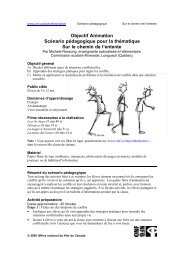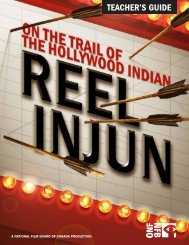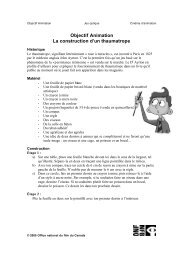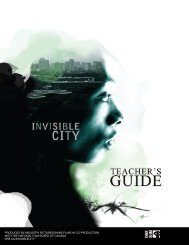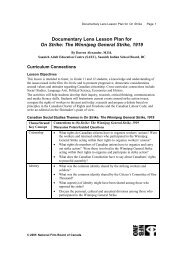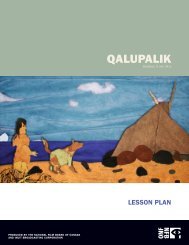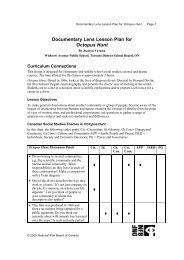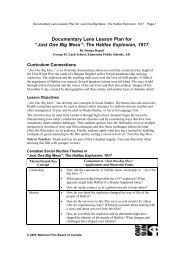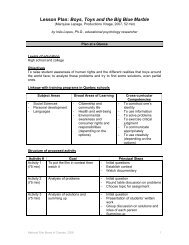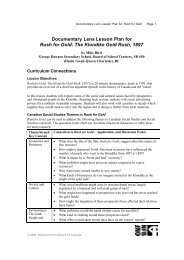Documentary Lens Lesson Plan for Inside Fighting Canada
Documentary Lens Lesson Plan for Inside Fighting Canada
Documentary Lens Lesson Plan for Inside Fighting Canada
- No tags were found...
Create successful ePaper yourself
Turn your PDF publications into a flip-book with our unique Google optimized e-Paper software.
<strong>Documentary</strong> <strong>Lens</strong> <strong>Lesson</strong> <strong>Plan</strong> <strong>for</strong> <strong>Inside</strong> <strong>Fighting</strong> <strong>Canada</strong> Page 1<strong>Documentary</strong> <strong>Lens</strong> <strong>Lesson</strong> <strong>Plan</strong> <strong>for</strong><strong>Inside</strong> <strong>Fighting</strong> <strong>Canada</strong>By Peter FlahertyPh.D., Department of Education, York University, Toronto, ONCurriculum developer <strong>for</strong> CBC and Maclean's magazineCurriculum ConnectionsThese lessons are based on the 1942 NFB documentary <strong>Inside</strong> <strong>Fighting</strong> <strong>Canada</strong>, directed by JeanMarsh. It was part of the series <strong>Canada</strong> Carries On, commissioned during the Second World Warby NFB founder and director, John Grierson.<strong>Lesson</strong> ObjectivesThis lesson is appropriate <strong>for</strong> high school courses on 20thcentury Canadian history. Crosscurricularopportunities include media studies, economics, politics, sociology, filmmaking.The activities focus on the role documentary films played in <strong>Canada</strong> during the Second WorldWar, when they were used to shape public opinion. Students will gain an understanding of howthe Canadian government wanted ordinary citizens to view their role in the war ef<strong>for</strong>t on thehome front as essential <strong>for</strong> the victory of the Allies over Nazi Germany. The film alsoemphasized that Canadians, through their collective ef<strong>for</strong>t during the war, were laying thefoundations <strong>for</strong> a better society.Students will gain a deeper awareness of wartime propaganda, develop multiple perspectives <strong>for</strong>viewing and interpreting this film, recognize how it would have shaped citizenship and nationalidentity during wartime, and gain a deeper understanding of how participating in WW II defined<strong>Canada</strong> as a nation and served to promote national unity.Fundamental Concepts in Canadian Social Studies CurriculaTheme/Strand/Key ConceptCitizenshipMultiplePerspectivesIdentityConnection to <strong>Inside</strong> <strong>Fighting</strong> <strong>Canada</strong> –Applications and Discussion Points• How would this film have promoted citizenship among Canadians living indifferent regions of the country?• Why would it be important <strong>for</strong> the Canadian government to encourage, duringwartime, a greater awareness of citizenship?• In what ways would their participation in a major collective undertaking like anational war ef<strong>for</strong>t raise Canadians’ awareness of themselves as citizens?• As a Canadian living in the early 21st century, how do you react to thein<strong>for</strong>mation, images and messages of this film from the Second World War era?• How do you think Canadians would have responded in 1942?• Do you think a film such as this would have the same impact if it were madetoday?• How would this film have promoted a greater sense of national identity amongCanadians?• Why would it be important <strong>for</strong> the Canadian government to promote a sense ofnational identity during wartime?© 2005 National Film Board of <strong>Canada</strong>
<strong>Documentary</strong> <strong>Lens</strong> <strong>Lesson</strong> <strong>Plan</strong> <strong>for</strong> <strong>Inside</strong> <strong>Fighting</strong> <strong>Canada</strong> Page 2Theme/Strand/Key ConceptPower,Authority, andGovernanceThe Land:Places andPeopleGlobalConnectionsEconomics andResourcesConnection to <strong>Inside</strong> <strong>Fighting</strong> <strong>Canada</strong> –Applications and Discussion Points• What evidence is there in the film that during the war Canadians weredeveloping a stronger sense of their national identity, distinct from Britain andthe United States?• What role did the Canadian government play in the overall direction andorganization of the war ef<strong>for</strong>t during WW II?• How does the film promote the idea of a partnership between the governmentand ordinary citizens in the war ef<strong>for</strong>t on the home front?• How does the film convey the idea that government is a positive <strong>for</strong>ce <strong>for</strong>organizing an economy and society, during wartime and in the post-war era?• In what ways might this film familiarize Canadians with the various regions ofthe country?• What specific and important roles did different regions of the country play in thewar ef<strong>for</strong>t?• How does the film convey a sense of unity or inter -connectedness among peopleliving in different regions of the country?• How does the film convey a sense of the vastness of <strong>Canada</strong> and itsgeographical or natural barriers to settlement and development?• In what ways does the film present the concept of the struggle between peopleand nature in the development of a society and economy in <strong>Canada</strong>?• How does the film present the message that <strong>Canada</strong>’s war ef<strong>for</strong>t during WorldWar II was an important part of the overall Allied struggle against NaziGermany?• In what major battlefronts were Canadian <strong>for</strong>ces active? How is thisinvolvement portrayed in the film?• How would this film have fostered a greater awareness of <strong>Canada</strong>’s role in theworld?• What important natural resources from <strong>Canada</strong> helped the war ef<strong>for</strong>t?• How does the film convey the idea that <strong>Canada</strong> was blessed with naturalresources that could be used to help in the Allied war ef<strong>for</strong>t?• How does the film link our major natural resources to different Canadian regionsand to the national war ef<strong>for</strong>t during the Second World War?• How does the film convey the idea that <strong>Canada</strong>’s economy was growing <strong>for</strong> thebenefit of ordinary people during the Second World War?• What messages does the film convey about the prospects <strong>for</strong> economic andsocial development in <strong>Canada</strong> once the war had been won?• How does the film portray the role of government in the direction of theCanadian economy during the war?• How does the film emphasize that Canadians <strong>for</strong>med the country’s mostimportant and valuable natural resource during the Second World War?© 2005 National Film Board of <strong>Canada</strong>
<strong>Documentary</strong> <strong>Lens</strong> <strong>Lesson</strong> <strong>Plan</strong> <strong>for</strong> <strong>Inside</strong> <strong>Fighting</strong> <strong>Canada</strong> Page 3Assessment Strategies• Activities 1 and 2: Assessment of student answers to pre- and post-viewing questions (seeworksheet 1), or short written response report on their viewing of the film.• Activity 3: Worksheet 2, a quiz, will help determine students’ understanding.• Activity 4: a) Evaluation of group presentations of critical analyses of the film as an exampleof wartime documentary propaganda and b) written report summarizing the group’s mainideas about the film and their reactions to it.• Activity 5: Peer and/or teacher evaluation of student presentations of a particular example ofwartime propaganda.• Extension Activities: Evaluation of any of the suggested activities.BackgroundThe Second World War profoundly trans<strong>for</strong>med Canadian society. The economic crisis of theGreat Depression came to an end. An economic boom began after <strong>Canada</strong> declared war onGermany in September 1939. The war meant full employment <strong>for</strong> Canadians on the home frontand the raising of a volunteer army, navy and air <strong>for</strong>ce that eventually numbered 390,000 menand women (out of a total national population of 12 million). Economic growth increaseddramatically as <strong>Canada</strong> provided food, lumber, minerals and other primary products to the waref<strong>for</strong>t in Britain and other Allied nations. Manufacturing, construction, and skilled trades such asengineering also became more important. <strong>Canada</strong> was the main base <strong>for</strong> the training of Alliedairmen through the British Commonwealth Air Training <strong>Plan</strong> (BCATP). <strong>Canada</strong>’s relationshipwith the United States became closer as a result of mutual defence pacts and the construction ofthe Alaska Highway.Government played a major role in the direction of the wartime economy and the allotment ofresources. Wages and prices were strictly controlled. Canadians were strongly encouraged tosupport the war through rationing, purchasing war bonds, and compulsory savings plans. Womenplayed a greater role in the work<strong>for</strong>ce than ever be<strong>for</strong>e, replacing enlisted men. The war created asense of solidarity and collective ef<strong>for</strong>t among ordinary Canadians, who were encouraged to viewtheir participation in the fight to defeat Nazi Germany as the first step in building a moreprosperous and egalitarian society in the post-war era. All regions of <strong>Canada</strong> played their part onthe home front, and contributed their share to the overall war ef<strong>for</strong>t that united Canadians fromsea to sea.Activities <strong>for</strong> <strong>Inside</strong> <strong>Fighting</strong> <strong>Canada</strong>IntroductionThe purpose of these introductory activities is to provide a basic knowledge of the role <strong>Canada</strong>played, especially on the home front, during the Second World War. The film is only 11 minuteslong, and it should be possible <strong>for</strong> students to view it twice during the lesson.ACTIVITY 1: Pre -viewing InquiryAsk students to think about, brainstorm and discuss the first set of questions in worksheet 1.Write the answers on the board. Or, have students <strong>for</strong>m small groups to prepare and presentconcept maps on chart paper, using “war” as the term to which they can link related concepts.Have each group present their ideas to the class.© 2005 National Film Board of <strong>Canada</strong>
<strong>Documentary</strong> <strong>Lens</strong> <strong>Lesson</strong> <strong>Plan</strong> <strong>for</strong> <strong>Inside</strong> <strong>Fighting</strong> <strong>Canada</strong> Page 4ACTIVITY 2: Post-viewing InquiryAfter students have viewed the film, have them <strong>for</strong>m small groups to discuss their initial reactionsto the film. Still using worksheet 1, ask each group to record the main ideas raised in thediscussion and to choose one person to present their ideas to the class.Ask the representative from each group to report to the class. You can write some of the mainideas on the board. Together, look <strong>for</strong> similarities and differences and discuss.ACTIVITY 3: In<strong>for</strong>mation Gathering and RecordingShow the film again. Ask student to answer the questions in worksheet 2. (The answer sheetfollows it.)Developing UnderstandingACTIVITY 4: Critical Analysis of <strong>Inside</strong> <strong>Fighting</strong> <strong>Canada</strong>Distribute copies of worksheet 3.Working in small groups, students will prepare and presentcritical analyses and evaluations of the film as wartime propaganda, and state and defend theirpositions on the value of such films during periods of serious national crisis such as wartime.Applying What They Have LearnedACTIVITY 5: Creating World War II PropagandaStudents apply the concepts and skills they have acquired by presenting their own example of apiece of WW II propaganda. Working in groups, students can choose from the following list:• Newscast: a CBC radio broadcast dramatizing one or more aspects of <strong>Canada</strong>’s role in theSecond World War on either the home or battlefront, as portrayed in <strong>Inside</strong> <strong>Fighting</strong> <strong>Canada</strong>.• Newspaper article : an article or editorial from a Canadian newspaper published during WW IIdealing with a major news story or issue arising from that conflict.• Interview: an interview with a leading Canadian political or military figure from WW II or anordinary Canadian soldier, sailor, airman, or war worker involved in the war ef<strong>for</strong>t.• Dramatic role-play: a short dramatic presentation depicting an event or issue from World WarII involving Canadians, with students acting various parts “in-role”• Song or music: an original piece of music or popular song dealing with issues and/or events ofthe war and Canadians’ response to them.• Poster: a poster designed to promote a particular aspect of the war ef<strong>for</strong>t to the civilianpopulation (note: many Canadian history textbooks include examples of these).• Government advertisement: a federal government advertisement designed to promote aparticular wartime message to Canadians (<strong>for</strong> example, buying Victory Bonds, conservingscarce resources, being on guard <strong>for</strong> potential enemy activity).Each group should present their work to the class. At the end of the activity, ask each group whatthey learned about wartime propaganda.Extension ActivitiesThe activities here could be assigned <strong>for</strong> independent study. These activities are designed <strong>for</strong>students of different grade levels, and some could be adapted to meet the needs of ESL students.© 2005 National Film Board of <strong>Canada</strong>
<strong>Documentary</strong> <strong>Lens</strong> <strong>Lesson</strong> <strong>Plan</strong> <strong>for</strong> <strong>Inside</strong> <strong>Fighting</strong> <strong>Canada</strong> Page 5ACTIVITY 6: Analyzing Examples of Wartime Propaganda from outside <strong>Canada</strong>Using examples from their Canadian and/or world history textbooks, or from the Internet,students could select a particular example of wartime propaganda from WW II that was notproduced in <strong>Canada</strong>, and subject it to a critical analysis similar to what they did <strong>for</strong> <strong>Inside</strong><strong>Fighting</strong> <strong>Canada</strong>.They should include: a) source of the propaganda (what country?) b) images conveyed c)message or theme of the piece d) why it is an example of propaganda e) effectiveness of theexample at the time it was produced and f) how stude nts today react and respond to it.ACTIVITY 7: Viewing and Analyzing Other NFB Wartime DocumentariesStudents could watch and analyze another NFB film from <strong>Canada</strong> Carries On (see <strong>Documentary</strong><strong>Lens</strong> Web site). Students could <strong>for</strong>m groups to view one of these films and prepare and presentreports on them <strong>for</strong> the rest of the class, using the same critical thinking skills they applied totheir analysis of <strong>Inside</strong> <strong>Fighting</strong> <strong>Canada</strong>. Or they could compare and contrast the themes, content,images, messages, etc. of these films to films produced in other countries during the same periodof wartime (e.g. American director Frank Capra’s Why We Fight series, or the works of theGerman director Leni Riefenstahl). Students interested in how the roles of women in <strong>Canada</strong>during World War II were portrayed in film might be particularly interested in Proudly SheMarches and how feminist historians have interpreted it.ACTIVITY 8: Critical Analysis of a Current <strong>Documentary</strong> FilmStudents could prepare a critical analysis of a recent documentary film, employing similartechniques that they used in their assessment of <strong>Inside</strong> <strong>Fighting</strong> <strong>Canada</strong>.© 2005 National Film Board of <strong>Canada</strong>
<strong>Documentary</strong> <strong>Lens</strong> <strong>Lesson</strong> <strong>Plan</strong> <strong>for</strong> <strong>Inside</strong> <strong>Fighting</strong> <strong>Canada</strong> Page 6Worksheet 1 <strong>for</strong> <strong>Inside</strong> <strong>Fighting</strong> <strong>Canada</strong>Pre-viewing and Post-viewing QuestionsPre-viewing questions1. Based on what you have already learned about Canadian history, what impact do you thinkthe Second World War had on <strong>Canada</strong>?2. What methods do you think the government would have used during the war to encouragesupport <strong>for</strong> the war among the general public?3. Why do you think it would have been important <strong>for</strong> the Canadian government to have publicsupport <strong>for</strong> the war ef<strong>for</strong>t?4. Can you give an example of a war occurring during your lifetime in which <strong>Canada</strong> has beeninvolved?5. What <strong>for</strong>ms of mass media are most important in in<strong>for</strong>ming people about international events(such as wars) today?6. How do you think most Canadians learned about the events of Second World War in 1942be<strong>for</strong>e there was television or the Internet?7. How do you think Canadians today would respond to a major crisis such as a full-scale war inwhich this country was involved?Post-viewing questions1. What are your general reactions to this film, based on what you know about <strong>Canada</strong>’s roleduring the Second World War?2. How do you think an audience viewing this film as a newsreel in a Canadian cinema duringWorld War II would have responded?3. How effective were the techniques used in the film? How did they dramatize the conflict inwhich <strong>Canada</strong> was involved (<strong>for</strong> example, aerial shots, scenes of bombs falling, themovement of troops, tanks, ships)?4. What do you think was the central theme of this film?5. How would you express the main messages of this film?6. What do you think were the main goals of the NFB officials who produced this film?7. How effective do you think the images in the film were in achieving the goals of thefilmmakers?8. How do you think Canadians of today would respond to a similar film about this country’sparticipation in a war?9. What important area where <strong>Canada</strong> was involved in the Second World War is not mentionedin this film?© 2005 National Film Board of <strong>Canada</strong>
<strong>Documentary</strong> <strong>Lens</strong> <strong>Lesson</strong> <strong>Plan</strong> <strong>for</strong> <strong>Inside</strong> <strong>Fighting</strong> <strong>Canada</strong> Page 7Worksheet 2 <strong>for</strong> <strong>Inside</strong> <strong>Fighting</strong> <strong>Canada</strong>In<strong>for</strong>mation Gathering and RecordingName _______________________________________Date _________________________1. On what continent are the devastated cities shown at the beginning of the film?2. On what two continents does the film portray the actions of Canadian armed <strong>for</strong>ces?3. In which of the following theatres of war–air, sea, or land–does the film show Canadian<strong>for</strong>ces?4. What is the motto of <strong>Canada</strong>? What national symbol does it appear on?5. What geographical regions of <strong>Canada</strong> are portrayed in the film?6. With what important wartime economic activities is each region linked?7. When did <strong>Canada</strong> declare war on Germany?8. How many Canadians were serving in the armed <strong>for</strong>ces when the film was made? How largewas the total Canadian population at that time?9. What important contribution did <strong>Canada</strong> make to the war in the air? What countries’ airmenwere trained here?10. How long was the coastline that had to be defended in the Second World War? What kindsof naval vessels were built in <strong>Canada</strong> then?11. During WW II, what was the major port of embarkation <strong>for</strong> Canadian troops and wartimesupplies <strong>for</strong> Britain and Europe?12. How much food per person was <strong>Canada</strong> shipping to Britain during WW II?13. During the war, what important transportation link was <strong>Canada</strong> constructing in partnershipwith the United States?14. What economic activities and industries were important to the war ef<strong>for</strong>t?15. What was the annual value of <strong>Canada</strong>’s wartime production of goods and services?16. According to the film, what was <strong>Canada</strong>’s most important wartime natural resource?17. Who was the prime minister of <strong>Canada</strong> during WW II?18. What roles do women portray in the film?19. Besides winning the war, what other important national goal is referred to?20. How is the motto of <strong>Canada</strong> referred to at the beginning of the film presented as a prophecyat the end?© 2005 National Film Board of <strong>Canada</strong>
<strong>Documentary</strong> <strong>Lens</strong> <strong>Lesson</strong> <strong>Plan</strong> <strong>for</strong> <strong>Inside</strong> <strong>Fighting</strong> <strong>Canada</strong> Page 8Worksheet 2 Answer Sheet1. On what continent are the devastated cities shown at the beginning of the film? Europe2. On what two continents does the film portray the actions of Canadian armed <strong>for</strong>ces? Europeand North Africa3. In which of the following theatres of war—air, sea, or land—does the film show Canadian<strong>for</strong>ces? air and sea war4. What is the motto of <strong>Canada</strong>? “from sea to sea” What national symbol does it appear on? coatof arms5. What geographical regions of <strong>Canada</strong> are portrayed in the film? Atlantic, Ontario and Quebec,Prairies, British Columbia, Arctic6. With what important wartime economic activities is each region linked? Atlantic(shipbuilding), Ontario and Quebec (manufacturing), Prairies (farming), British Columbia(<strong>for</strong>est industry), Arctic (mining)7. When did <strong>Canada</strong> declare war on Germany? September 10, 19398. How many Canadians were serving in the armed <strong>for</strong>ces when the film was made? 390,000How large was the total Canadian population at that time? 12 million9. What important contribution did <strong>Canada</strong> make to the war in the air? British Commonwealth AirTraining <strong>Plan</strong> (BCATP) What countries’ airmen were trained here? United Kingdom, Australia,New Zealand10. How long was the coastline that had to be defended in the Second World War? 24,000 miles(about 44,500 km) What kinds of naval vessels were built in <strong>Canada</strong> then? freighters,minesweepers, corvettes11. During WW II, what was the major port of embarkation <strong>for</strong> Canadian troops and wartimesupplies <strong>for</strong> Britain and Europe? Halifax, Nova Scotia12. How much food per person was <strong>Canada</strong> shipping to Britain during WW II? 200 pounds (90kg)13. During the War, what important transportation link was <strong>Canada</strong> constructing in partnershipwith the United States? Alaska Highway14. What economic activities and industries were important to the war ef<strong>for</strong>t? agriculture, mining,manufacturing, lumber, skilled technology15. What was the annual value of <strong>Canada</strong>’s wartime production of goods and services? $3 billion16. According to the film, what was <strong>Canada</strong>’s most important wartime natural resource? itspeople17. Who was the prime minister of <strong>Canada</strong> during WW II? William Lyon Mackenzie King18. What roles do women portray in the film? secretarial and child care activities19. Besides winning the war, what other important national goal is referred to? Building a postwarsociety that would be prosperous and fair <strong>for</strong> all.20. How is the motto of <strong>Canada</strong> referred to at the beginning of the film presented as a prophecy atthe end? Through the wartime ef<strong>for</strong>ts of its people, <strong>Canada</strong> would emerge from World War II as atruly united, strong, free, prosperous, and equal country “from sea to sea.”© 2005 National Film Board of <strong>Canada</strong>
<strong>Documentary</strong> <strong>Lens</strong> <strong>Lesson</strong> <strong>Plan</strong> <strong>for</strong> <strong>Inside</strong> <strong>Fighting</strong> <strong>Canada</strong> Page 9Worksheet 3 <strong>for</strong> <strong>Inside</strong> <strong>Fighting</strong> <strong>Canada</strong>Excerpts from National Film Board’s “Behind the Camera” andDiscussion Focus Questions1. What are the main goals of a documentary film?In general, documentary films educate their audiences. They share one or more of thesegoals: a) to document a subject in order to preserve knowledge; b) to reveal somethingabout a subject; c) to allow the viewer to experience what it is like to be the subject; andd) to advocate on behalf of a subject.2. What role did the NFB play in producing documentary films during World War II?The renowned British-born documentary filmmaker John Grierson led the NFB duringWorld War II. He believed documentary films served an important propaganda purpose:they could demonstrate to Canadians what they were fighting to preserve and tie thememotionally to a sense of national purpose. The NFB employed hundreds of people andcreated over a thousand films during the war. They were shown around the world. In<strong>Canada</strong>, travelling projectionists reached the smallest farming communities and lumbercamps.3. How does this film reflect the times in whic h it was produced?<strong>Documentary</strong> films, like all types of media, are created by people, so they reflect theattitudes, ideas, interests, and even prejudices of the filmmakers. The films also comefrom particular places and moments in history, so they tell us something about thesocieties and even the technologies of the time. A documentary made during World WarII, <strong>for</strong> instance, will look old-fashioned to us, particularly in its narration and music. Wemight also see that it reflects the wartime situation in which it was made.4. What can we learn from the study of documentary films made in different periods of history?Learning about how people express themselves through the media can teach us to see theunstated values of our culture. We are surrounded by hidden messages that come to usfrom the media. Although we are not aware of most of them, these messages caninfluence our attitudes and behaviour. Most Canadians probably believed theinspirational messages of the NFB films of World War II. During the War, peoplewatched the films together in theatres, school buildings, and church basements. Watchinga movie was a group experience, and movies rein<strong>for</strong>ced shared values. The NFBdocumentaries showed the war ef<strong>for</strong>t in a very realistic way, with all the authority thatcame from a government agency. Most people accepted them as realistic and true.5. How do we react to wartime documentary films today?Today, we may consider these World War II documentaries as deliberate propaganda,and we might question their truth. It is often easier to recognize the values and intentionsof the media in the past than of the media that surround us today. But we can apply whatwe learn from studying old films to become aware of contemporary media.Focus Questions <strong>for</strong> Group Discussions1. Refer to the chapters of your Canadian History book on the country’s role in the SecondWorld War. Note the definition of “propaganda” given in your book, and the specificexamples of wartime propaganda that were used in different countries during this conflict. Asa group, discuss what you think the term “propaganda” means, and arrive at a workingdefinition that can be applied to <strong>Inside</strong> <strong>Fighting</strong> <strong>Canada</strong>.© 2005 National Film Board of <strong>Canada</strong>
<strong>Documentary</strong> <strong>Lens</strong> <strong>Lesson</strong> <strong>Plan</strong> <strong>for</strong> <strong>Inside</strong> <strong>Fighting</strong> <strong>Canada</strong> Page 102. Imagine you are a Canadian living during WW II. How do you think you would respond tothe content, images and messages of this film? How do you think watching a film such as thisin a group situation would influence your response to it?3. How does the fact that you are young Canadians living over half a century after this film wasmade influence your responses to the film? How does your knowledge of World War II andits outcome, which a 1942 audience could not have had, also influence your reactions?4. How do you think each of the following aspects of the film rein<strong>for</strong>ce the message about theimportance of <strong>Canada</strong>’s war ef<strong>for</strong>t? a) images of wartime and peacetime activities b) imagesof various regions of <strong>Canada</strong> c) images of Canadians of all ages and walks of life d) imagesof important national symbols e) narration f) sound effects and musical score g) use oflanguage and verbal imagery h) images of Canadians at work in different war-relatedindustries and activities.5. As a group, prepare a critical analysis and evaluation of <strong>Inside</strong> <strong>Fighting</strong> <strong>Canada</strong> as anexample of a wartime documentary propaganda film. Based on your working definition ofpropaganda, discuss to what extent you think it meets the criteria of this genre ofdocumentary film. Do you think it is an effective piece of propaganda? Why/why not? Doyou think it was successful in achieving its aims? Explain.6. Do you think that it is possible to distinguish between “good” and “bad” propaganda? Howwould your response as Canadians to <strong>Inside</strong> <strong>Fighting</strong> <strong>Canada</strong> and a similar World War IIpropaganda film produced in Nazi Germany differ? How would your knowledge of WW II,the Holocaust, and other related historical events influence your responses? Do you thinkpropaganda can ever serve a useful or positive role? Explain.7. What aspects of <strong>Inside</strong> <strong>Fighting</strong> <strong>Canada</strong> mark it as an old-fashioned documentary? How doyou think such films differ from documentaries produced today that are advocating a politicalviewpoint?8. What (if any) messages and themes from <strong>Inside</strong> <strong>Fighting</strong> <strong>Canada</strong> might still be of value inCanadian society? What vision of a post-war <strong>Canada</strong> was presented in this film, as a means ofinspiring Canadians to fight <strong>for</strong> a better future? To what extent do you think this visionbecame a reality in the years following the end of the Second World War?9. Do you think that <strong>Canada</strong> today achieves the ideal of the united, free, prosperous, and equalnation that is held out as the hope of the future at the end of <strong>Inside</strong> <strong>Fighting</strong> <strong>Canada</strong>?10. The NFB as a government-run media agency produced <strong>Inside</strong> <strong>Fighting</strong> <strong>Canada</strong> in response toa specific national crisis – the Second World War. Can you think of any serious situationconfronting this country that might require a similar kind of media intervention on the part ofthe Canadian government today? Explain.© 2005 National Film Board of <strong>Canada</strong>




